Could Green Energy on Croatian Islands Become EU Funds Magnet?
As Poslovni Dnevnik/Darko Bicak writes on the 12th of August, 2020, when it comes to dealing with the particular needs of people living on Croatian islands, as well as the development of island economies, things can become very challenging. Apart from the obvious issue being the continual connection to the mainland, the biggest problem of all those living in Croatian islands is the infrastructure, and especially the flow of electricity.
That is why in recent decades, great efforts have been made across Europe to make the bloc's islands as energy-efficient as possible through the development of green energy.
With the entry into the EU, this has also been being carried out across Croatia's many inhabited islands. As such, the continued development of renewable energy sources on Croatian islands has gained new momentum, which is contributed by the fact that Croatian MEP Tonino Picula is the president of the parliamentary Intergroup for Seas, Rivers, Islands and Coastal Areas in his second term. He boasted that his lobbying had secured around four million euros in the new EU budget for the energy transition of Croatian islands.
"We've successfully pulled the islands out of political anonymity in Europe and imposed them as the engine of energy transition. The islanders are the most heavily called upon to manage the development of their islands and that is why I'm in favour of a long-term and lasting EU island strategy as the main instrument of support to the islanders,'' Picula pointed out.
The “The Future of the Energy Transition of the Island of Hvar” conference was recently held on the island of Hvar, when the strategic partnership between the Island Movement (Pokret otoka) and the Renewable Energy Sources Association of Croatia (OIEH) should be signed. This is to make the best possible use of money from EU funds and their Green Plan project. As Maja Pokrovac, Director of OIEH, explained, the EU has offered a plan for recovery from the coronavirus pandemic worth a massive 750 billion euros, of which at least 30 percent must be spent on climate protection and the reduction of greenhouse gas emissions.
"EU member states must prepare their recovery plans within their national programmes, which should include investment and reform priorities, and submit them by April 2021. In its plan, Croatia should focus on activities that can start the economy up again, on a sustainable basis, and have it be closer to carbon neutrality,'' she said, adding that the energy transition of Croatian islands is one such activity.
"With this agreement with Hvar, we want to ensure the timely information and preparation of projects ready for financing in the areas of Croatian islands and to advocate for the well-being of island communities and their participation within these development projects. Therefore, we'll cooperate across all areas of common interest, including the development of RES on the islands, and especially on energy project development activities, the preparation of project studies, community involvement, strategic planning and consulting the Island Movement in the field of energy, information and education. The transition to clean energy sources can help Croatian islands become self-sufficient and open new employment opportunities for people living on them,'' said Pokrovac.
However, she added that the entire population, representatives of local and regional self-governments and entrepreneurs, civic initiatives and cooperatives, educational institutions must all be involved in the implementation process.
As many as ten Croatian islands: Cres, Ilovik, Lošinj, Male and Velike Srakane, Susak, Unije, Brac, Hvar and Korcula are currently implementing projects to prepare for the transition to clean energy.
For more, follow our lifestyle page.
Discovering Lastovo, Croatia's Southernmost Inhabited Island
August 10, 2020 - The southernmost inhabited Croatian island, Lastovo, together with other 45 islets, cliffs, and reefs, is Croatia's youngest nature park. Due to the richness of the Mediterranean plants and endangered animal species, Lastovo is among the last ten treasures of Mediterranean biodiversity. Along with Mljet, Lastovo is the most heavily forested Croatian island, with about 70% of it covered with forests. The larger settlements on the island are Lastovo, Ubli, Pasadur, Zaklopatica and Skrivena Luka.
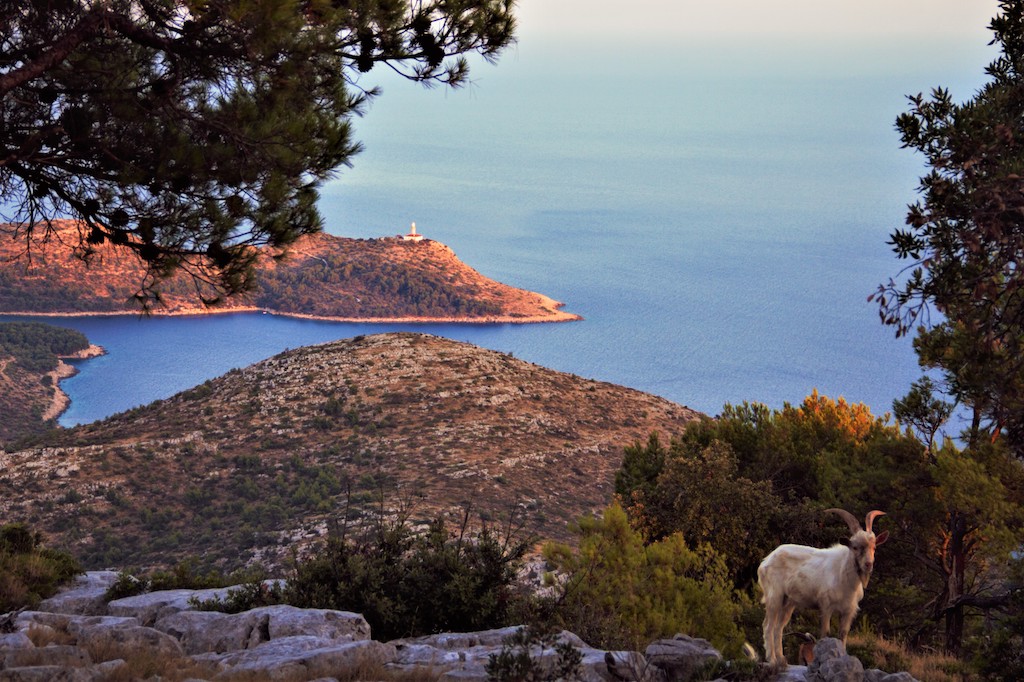
The hilly landscape formed by numerous karst fields and bays is ideal for those who enjoy recreational cycling. The seabed rich in caves and passages is a paradise for diving lovers. Of the diving sites, the most attractive and the most visited are Seka Drašan and Petrovac.
In addition to the above activities, visitors can enjoy hunting, recreational and sport fishing and star gazing. Lastovo is an island with one of the darkest skies in Europe and among tourists, it's also known as „the island of crystal stars“.

According to the 2011 census, Lastovo has 792 inhabitants, but the real number is much lower. In the last ten years, many have moved away and the number of those who are registered there, but actually live and work elsewhere, is not negligible.
Most islanders are engaged in tourism and related activities such as agriculture, fishing and trade. Since the season on Lastovo is very short, tourism is not the only branch from which most residents live.
„Part of the population is employed in the institutions located on the island, such us JUPP Lastovo islands, Elementary School Braća Glumac, police, army, post office, state administration office… There are those whom agriculture, tourism or fishing is the only source of income, so when the season is over, after a short break, preparations for the next one begin very quickly“, says Bruna Rizvanović, director of the Tourist Board of the Municipality of Lastovo.
In terms of tourism, last year was a record for the number of overnight stays.
„Due to the tendency to increase in number of overnight stays in the last seven years, we believed that it would continue by at least 5-10% in terms of capacity. We planned our activities accordingly. However, this epidemic surprised us all and showed that the future is unpredictable. I believe that we will be able to push through this year and that this experience will help us to become even better and to develop in line with sustainable tourism“, she explains.
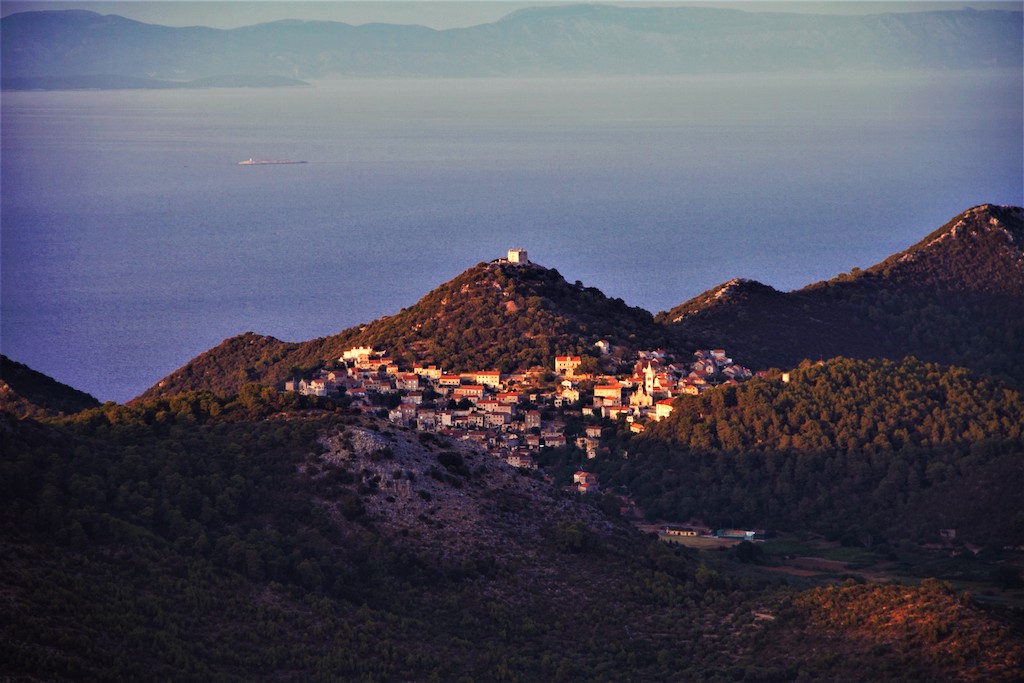
During July 2020, 74.21% of last year's arrivals and 73.79% of last year's overnight stays were realized in the municipality of Lastovo. All catering facilities are open, but most of them opened later than planned, due to the COVID-19 pandemic.
As for the music festivals for which Lastovo is famous, one has not been held, and the other will be held from 12th to 16th of August.
„The 'LUZ – Lastovo u zvijezdama' festival was not held this year, but the reason was not the current situation, but technical difficulties with the organization. I believe and hope that next year, the organizers of LUZ will meet again and continue the tradition of a diverse program and offer in the pre-season period, which is extremely important for our island“, Rizvanović adds.

This year's edition of festival LAstovo.OTOKGLAZBE. adheres to a slighty different concept of organization due to the situation caused by the COVID-19 pandemic and the attitude of organizers about the importance of ensuring the health of visitors. Because of it, it will be held in a much smaller capacity, without the organization of a camp and with fewer visitors than usual.
DJ D-Gree, Stray Dogg and Mary May are responsible for the music program, while the young contemporary circus collective Madame Gauc will perform the show „Fil“. In addition to the abovementioned program that will take place in MihajLA bay, part will take place in the village of Lastovo.
Rizvanović believes that the results of this tourist season are more than good, considering the situation in the rest of the county.
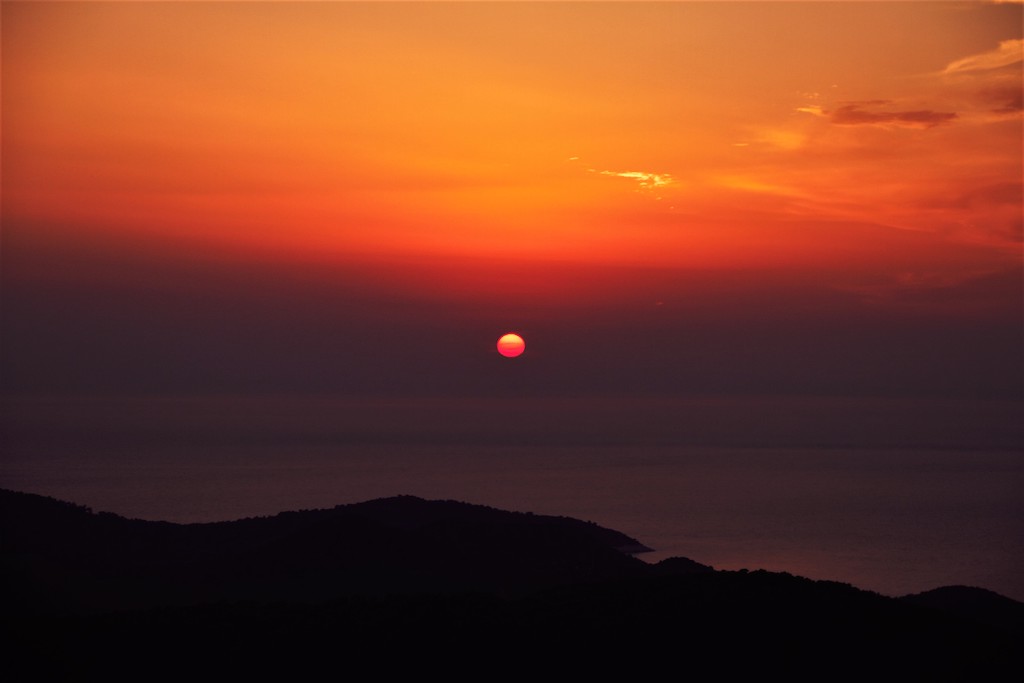
„I believe that the distance of the island from large city centers and the lack of crowds, but also the fact that we didn't record any cases of COVID-19, have affected that the results of tourist traffic are higher than expected. People feel safe knowing that the possibility of infection on the island is small“, Rizvanović concludes.
For the latest travel info, bookmark our main travel info article, which is updated daily.
Read the Croatian Travel Update in your language - now available in 24 languages
Jadrolinija's Summer Prices Remain at 2019's Levels, Islanders Disgruntled
If there is one bone of contention or thorn in the side, if you will, of Croatia's many island inhabitants, it is that there are either issues with maritime transport to the mainland and back again, or that the prices are too high. Islanders do get island cards and often pay lower prices to use the services of let's say, Jadrolinija, but this doesn't stop the complaints.
As Morski writes on the 27th of May, 2020, we have only got a few days to go until entry into force of Jadrolinija's summer sailing schedule, which has further upset the already irritated Croatian islanders who have been in isolation, separated from the mainland for months now.
The sore point for the majority of the islanders is the fact that Jadrolinija's prices will remain the same as they were last year, which as we all know, was a record year for Croatian tourism. That ship soon sailed, however, (no pun intended), with the outbreak of the coronavirus pandemic which saw tourism across the globe grind to a very sudden halt. It isn't just the pockets of the islanders which have been hit, and this leaves them wondering just who will visit the central Dalmatian islands in such circumstances, when finances are tight?
HTV stated that Croatia's premier island of Hvar is empty. There are no yachts and no guests. The elite hotels that once boasted of their offers and their guests are closed.
Jadrolinija's summer sailing schedule should finally bring in a handful of guests from nearby markets, including domestic tourists, but the prices being the same as last year when Croatia enjoyed a record tourist year is unlikely to draw many people to the islands.
''I think the time has come for Jadrolinija to reconsider its prices and to help us simply get through this summer by reducing their prices to a level that would satisfy both them and us. Let it be 50 percent lower when compared to last year,'' said the president of the Hvar Craftsmen's Association, Katica Vucetic.
For more on Jadrolinija and travel throughout Croatia and its many islands, follow our travel page.
The Great Demographic Shift on the Dalmatian Islands
For decades we've all been hearing about the drastic reduction of the population on Croatia's Dalmatian islands. Now it seems that the trend might finally be reversing!
Although most islands still have a negative population trend because of the reduced number of births and people leaving them to go and live elsewhere, there are examples of the exact opposite happening. Damir Šarac writes for Slobodna Dalmacija not just based on stories and anecdotes, but referring to the real numbers issued by the Croatian Bureau of Statistics.
In the category which follows migration state-wide, in the period between 2013 and 2018, data shows that some of the Dalmatian islands are the undisputed champions. Among the municipalities with over a thousand inhabitants, the biggest growth has been seen in Šolta (23 percent), Sali on Dugi otok (16 percent) and Vir (14 percent). When it comes to towns with population growth, Novalja on Pag is the first (almost 10 percent growth), and Vis is second (6 percent).
While other islands congratulate them on their successes, mayors and municipality heads highlight that these are the results of years of policies aimed at increasing the number of inhabitants and making it easier for people to find work on Dalmatian islands. The sad side of the story is that so many people have already left the islands, and such a small number of people are still living on them, that it takes a very small number of births or arrivals to make that type of difference we've seen in the last paragraph.
The first example is Šolta, which can be seen as a Split suburb as it's close to Split and is well connected through ferry and catamaran lines (eight during the summer, six during the winter).
These measures allow people to live on Šolta and work in Split. The municipality, headed by Nikola Cecić Karuzić (in his third term, as an independent candidate) gives support for each newborn, they've opened a kindergarten and the number of children in their school is growing each year. There are a total of 92 foreigners living there, mostly from European countries, who have recognised Šolta as an island that makes for a nice life.
Šolta has no surtax, some other taxes are also at zero, and, interestingly enough: there are no unemployed people on Šolta! They need workers constantly, anybody who needs a job can find one on Šolta - and that leads to them having over 400 inhabitants more in 2018 than they did in 2011.
The Mayor of Vis, Ivo Radica of HDZ, is a bit sceptical about the numbers, saying that some of the people just register on the island in order to use the benefits from that, while they're actually living elsewhere, but he does think that some improvements have been made.
He says that the only way to increase the population is to give people a place to stay and work and that everything else is demagogy. Apartments are being built on the island, and families with children get sizeable benefits on Vis. However, he highlights that it's necessary to have people move to the island as well, and adds that four families have moved to Vis this year, one of them from Dubai. Some major projects (tourist and infrastructure) are planned on Vis, which means that more workers will be needed.
The Sali Municipality is known as the municipality in Croatia that gives out the biggest financial support for each newborn child - a massive 60 thousand kuna! That has certainly helped, as the schools are seeing the increased number of students (for instance, a school in Sali has 14 pupils in the first grade, and there were only 5 last year). The biggest problem for Dugi otok is that they're not connected to the water supply system from the mainland, and the water that can be obtained on the island isn't enough for the tourist season. However, new investments and projects are announced which might solve that problem.
RokOtok - A Father's Project to Swim to All Croatian Islands to Start
We've already written about Domagoj Jakopović and his project RokOtok on TCN. Now there are more details on the endeavour available, as Ribafish (almost everyone in Croatia knows Domagoj by his nickname) has put out the planned schedule for this year.
Domagoj plans to swim to all of the inhabited islands in Croatia, as a homage to his son Rok, who passed away last year.
Their idea was to visit all of those islands together, and they managed to "conquer" eight of them. Now Domagoj will continue the work on his own while trying to get children and their parents to come out to meet him on the islands, learn about the history and interesting facts, find out about the responsible garbage disposal and other sustainable practices, as well as find hidden treasures.
Domagoj was a geography teacher back in the day, so he'll also tell the children about the various resources that will help them grow up to be responsible adults, and encourage them to do activities away from any screens, such as swimming with him and many others.
There are over fifty inhabited islands along the Croatian coast, so it would be nearly impossible for one person to swim between all of them in one year - even for Domagoj, who has been a long-distance swimmer for a while. So, when he published the schedule for this year, it came as no surprise that he chose to only swim to a portion of those islands in the first year.
This year, there are seventeen Southern and central Croatian islands on the plan: Koločep, Lopud, Šipan, Mljet, Korčula, Lastovo, Šćedro, Hvar, Vis, Biševo, Brač, Šolta, Drvenik Veli, Drvenik Mali and Čiovo (Prežba near Lastovo and Veliki Budikovac near Vis are not entirely inhabited, but will be a part of Ribafish's journey this year.)
The schedule was posted on the project's website, rokotok.hr, and you can find it below:

For each leg of the trip, you can see the time of the start, the distance to swim and the projected time it will take Ribafish to do it; "dan odmora" means "rest day". If you're able, join Ribafish on the islands, bring your children along, let them learn something, swim with him, and enjoy the time spent with them outdoors!
The beginning of this adventure will be next Saturday, July the 6th, in Dubrovnik, on Lapad beach. The Croatian media will be following Ribafish's journey with the idea of bringing children and their parents back together, in nature, without ant screens.
If you want to support the project, you can make a donation to the Rokotok Association, which has been established mostly for this purpose:
RokOtok, udruga za promociju aktivnog i zdravog života djece (the association for the promotion of the active and healthy lives of children)
IBAN: HR3224840081135112591
SWIFT: RZBHHR2X
additional questions: This email address is being protected from spambots. You need JavaScript enabled to view it.
(This is a multi-currency bank account and you should be able to send most currencies to it: EUR, USD or any other currency)
European Union Affirms Energy Transition of Croatian Islands
As Morski writes on the 7th of June, 2019, the European Commission (EC) has recognised the value of the energy transition of European islands in 2019, in line with the Clean Energy for the EU islands initiative, the foundation of which can be credited to Croatian MEP, Tonino Picula.
The relevant text from the European Commission states quite specifically that there is a great potential for investing in wind and solar energy and energy from renewable sources for heating and cooling. Promoting such investments could increase the energy self-sustainability of Croatian islands, in line with the Clean Energy Initiative for the European Union's islands.
''I was very pleased to receive the news of additional affirmation and support for the European island transition policy, which was announced today by the European Commission. It's a confirmation that there is room for completely new initiatives and programs for raising the quality of life of EU citizens,'' said Tonino Picula, who will begin his third term in the European Parliament at the beginning of July this year.
He stressed that such clear support to the program, as has been strongly expressed by the European Commission, would be an additional argument to see an increase the European Comission Secretariat's budget to more than one hundred million euros during the next budget period.
Among the list of items in the European Commission's focus are investment policy on research and innovation, sustainable urban and rail transport, energy efficiency, renewable energy sources and environmental infrastructure, all of which are clearly highlighted, taking into account regional differences and increasing the capacity of the competent bodies to realise and implement public projects and policies, which Picula has often emphasised in all of his recent criticisms of the current capacity of Croatian institutions to properly carry out this demanding job.
Picula, along with his colleagues in the European Parliament, initiated the need for the adoption of a resolution on the special situation of the islands, which the European Parliament quickly recognised as the need to adopt special policies relating to islanders and their lives, given that they are often greatly different to that of people living on the mainland.
To briefly recall, as many as ten Croatian islands, out of a total of fifty of the country's inhabited islands, are participating in energy transition pilot projects, which makes Croatia the most successful member of the EU in this competition.
Cres, Ilovik, Lošinj, Male Srakane, Susak, Unije, Velike Srakane and Brač, Hvar and Korčula have been enabled to prepare for the use of renewable energy sources, which will help these islands to better preserve the environment and raise the quality of life of their inhabitants.
Follow our dedicated lifestyle and politics pages for much more.
UNESCO Heritage of Croatia - Vis Archipelago UNESCO Global Geopark Croatia
May the 27th, 2019 - taking a closer look at beautiful Vis and its UNESCO heritage.
On the 17th of April, 2019, the UNESCO Executive Board approved the designation of eight new Global Geoparks which demonstrate the diversity of the planet’s geology. Croatia's Vis archipelago got this recognition. This article will take a closer look into some natural heritage from the stunning Vis archipelago.
The Vis archipelago covers the island Vis and the surrounding islands and islets Biševo, Sveti Andrija, Brusnik, Jabuka, and Palagruža. The archipelago is the area that has the oldest and youngest geological formations.
Some parts of the archipelago are made from volcanic rocks while most of the Adriatic islands are made from sedimentary rocks. Sailors and fishermen were always aware of this specific geological area. They knew when they would sail close to volcanic islets of Jabuka and Brusnik as their compass would divert from the north, potentially putting them in danger. Vis island has parts where the foundation is volcanic rock, which created several water springs. These springs created fertile conditions, so it's no wonder the ancient Greeks chose Vis about 2,400 years ago as the place to found their first colony on the Adriatic.
The Vis archipelago is located off the coast of Croatia, and there some of the oldest rocks in the Adriatic sea, formed 220 million years ago, can be found. Sedimentary rocks are the base for most of the Vis archipelago. The origin of these rocks comes from the lithification process of sand, mud, and sea organisms.
The north-eastern region of the archipelago includes large sand deposits formed in the Ice Age which created unique forms and caves. Before the sudden rise of the sea level 12000 years ago, these islands were much larger and extended more than twenty miles. In this extended area called Mala Palagruža, an archaeologist discovered flint quarries that served for the production of early tolls believed to have been made by the islands' first inhabitants.
The Vis archipelago is formed around Vis island and includes a number of nearby uninhabited islets: Ravnik, Budihovac, Veli Paržanj, Mali Paržanj, Greben, Host, Veli Barjak and Mali Barjak and the open sea islands among which the most remote are the island of Palagruža, inhabited only by lighthouse keepers, and the magmatic island of Jabuka, some 30 nautical miles west of Vis. The surface of this maritime area covers almost 6000km2 and also includes Sveti Andrija, Brusnik and the island of Biševo which, is the only inhabited island.
In this area, the largest number of ''monuments of nature'' in Europe can be found – Blue Cave, Monk Seal Cave, the volcanic islets of Jabuka and Brusnik, Stiniva Cove, and the Green Cave on the islet of Ravnik.
The Vis archipelago is a small area, but it boasts a wide range of significant landscapes and protected monuments of nature, some of which attract a lot of visitors.
The Blue Cave
In 1884, the Viennese painter baron Ugen Ransonnet introduced the Blue Cave on the island of Biševo to the world. His discovery marked the beginning of tourism in Dalmatia, and the Blue Cave has since become a must-see tourist spot in the Adriatic. The Blue Cave has been a protected geomorphological monument of nature since 1951. Visitors can go to the cave from Biševo Mezoporat. There are people all over the world visiting this unique cave every summer.
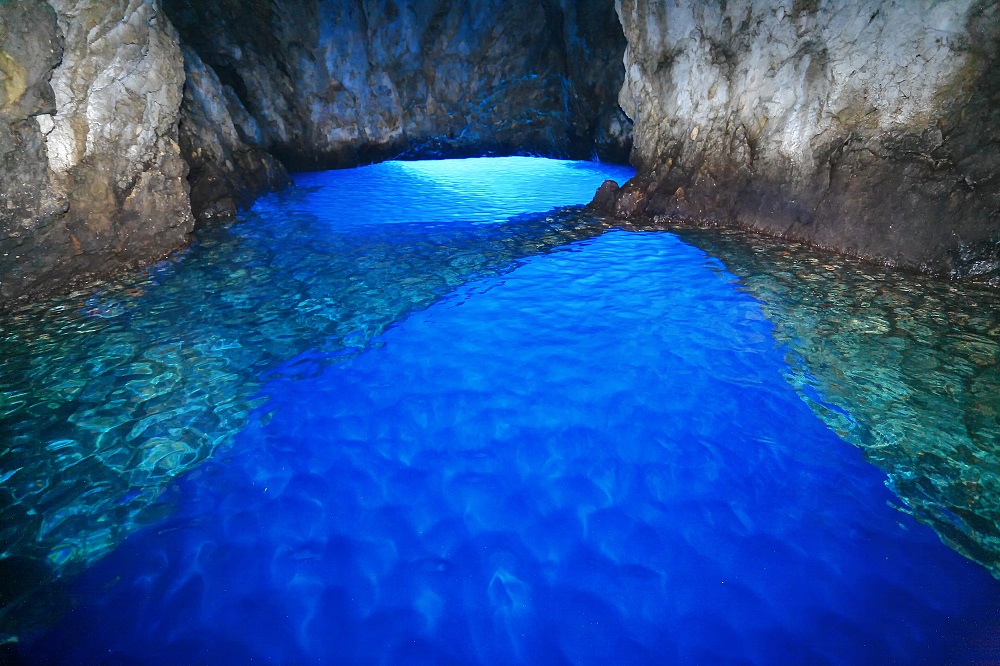
The Monk Seal Cave
The Monk Seal Cave is the longest sea cave in the Adriatic – 160 metres. It is a protected geomorphological monument of nature from 1967. The name comes from the Mediterranean monk seal which once lived here.
Jabuka islet
Rising above the sea like a black pyramid, the island is 30 nautical miles from Komiža, is 97 metres high, and is a protected geomorphological monument of nature from 1958. The island is composed of deep crust magmatic rocks, the magnetite of which interferes with seafarers’ compasses making navigation in conditions of poor visibility extremely difficult when near it. The underwater area is rich in fish and crabs, which is why fishermen from Komiža go to Jabuka in winter and risk their lives going to the island, which has no docks.
Jabuka doesn’t have a natural bay and doesn’t provide shelter from the wind. Anchoring a boat is a difficult task due to the deep sea around the island, and its smooth rocks polished by the sea make it impossible to tie the ship around them. There are as many as twenty toponyms here, and these are the only human traces on this further insular frontier of the eastern Adriatic. The island is made from volcanic diabase rocks and is home to the endemic black karst lizard and two endemic plants.
The Green Cave on the islet of Ravnik
This cave is a protected geomorphological monument of nature from 1967, and the islet itself is a significant landscape. The Green Cave has two large openings to it and it doesn’t give the same type of blue light effect as the Blue Cave, but it's entirely unique because it has a small opening in the middle from where sunlight breaks into the cave and lights up the sea bottom like a spotlight in the darkness. The blackness of this cave enhances the intensity of this miraculous spotlight.

Stiniva bay
Stiniva bay has been classed as a significant landscape since 1967. This narrow and long bay ends with a stone ''gate'' leading into a small cove with a pebble beach surrounded by layered rock walls. Once, Stiniva was a karst cave and it probably collapsed several thousand years ago. In 2016, Stiniva was named the most beautiful beach in Europe.
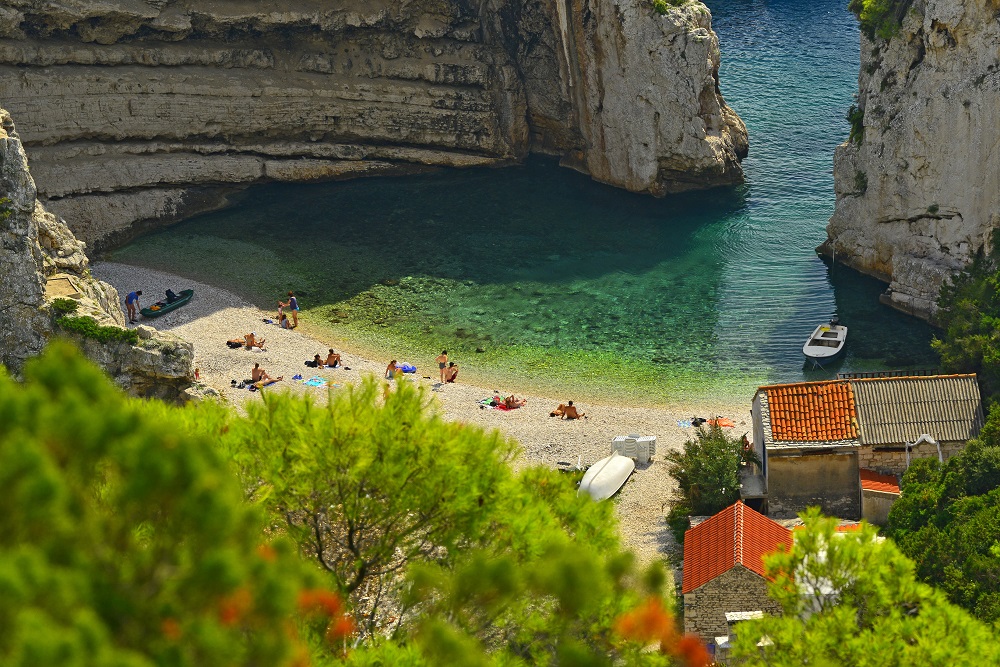
Ravnik islet
Ravnik islet is a significant landscape of nature and is located off the eastern coast of Vis, boasting its green cave.
Brusnik
Brusnik is the protected geomorphological monument of nature and is located thirteen nautical miles from Komiža. Brusnik and Jabuka are the only islands in the Adriatic formed from igneous rocks. It is 23 meters high, and both Brusnik and Jabuka are made of subvolcanic diabase formed by the crystallisation of magma on its way from the deep magmatic core up to the surface. Brusnik island is far more complex than Jabuka, however. Brusnik has paleo beach pebble conglomerates which can be found on the top of the island.
In the middle of the island, there is a ravine with a depression filled with seawater used by fishermen from Komiža, in which they made larger pools to keep their captured lobsters. There are also the remains of fishermens' cottages built from large rocks. These small homes were in use for salting fish in barrels and to keep the fishermen safe from the wind and sun. Brusnik has been a protected area since 1951 and it boasts a special structure – as most of the islands have a limestone base.
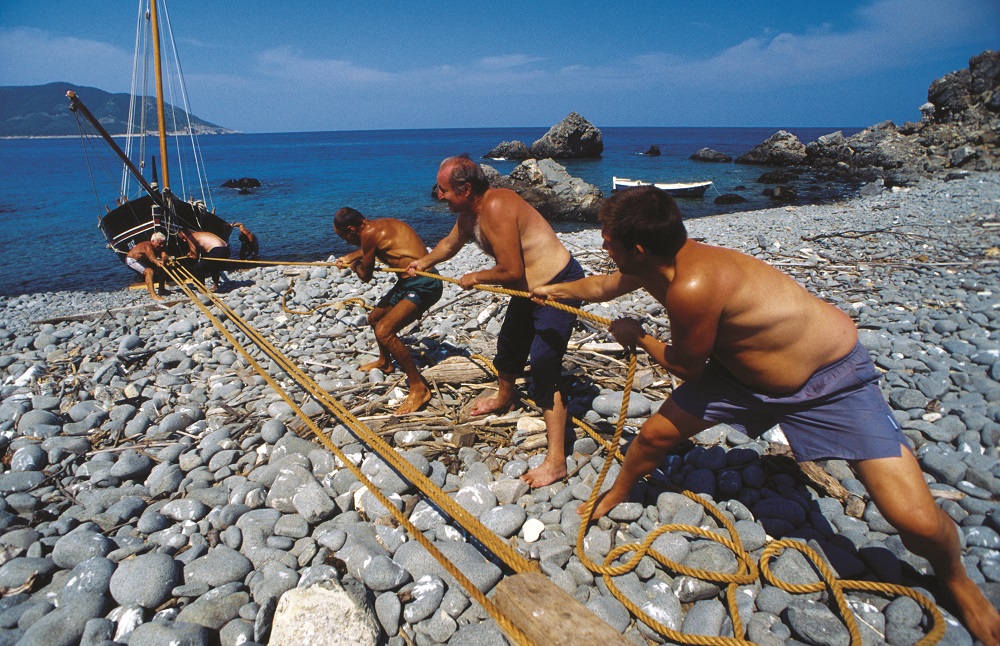
There are several geo-trails in Vis archipelago, here are a few handy links to them:
Geo trail Komiža: https://geopark-vis.com/en/geology/geo-trails
Geo trail Biševo: https://geopark-vis.com/en/geo-trail-bisevo
Geo trail Vis Rukavac: https://geopark-vis.com/en/geostaza-vis-rukavac
A list of geological locations can be found here: https://geopark-vis.com/en/geostaza-vis-rukavac
With this geological area, there are naturally a lot of local traditions and pieces of heritage worth knowing about. Some of the most valuable are Gajeta Falkuša, Suhozid – dry stone walling (another piece of Croatia's intangible UNESCO heritage), The local Vis dialect, Gajeta Falkuša, which is a traditional historical fishing boat. Fishing has been the traditional main occupation of local men from Komiža for centuries. Komiža fishermen are well known as the first to catch fish on the open sea and to face a lot of dangers due to poor weather conditions and pirate attacks.
Local inhabitants lived off the sea and were facing different threats. To fight the open sea and the risks that faced them, fishermen needed to have small and quick boats which could carry a lot in them too. To survive these rough conditions, they made falkuša – a unique traditional fishing boat from Komiža. It is made for fishing, sailing and cargo carrying. The name comes from the word falka, or the sideboards of the ship which enabled the boat to be used for different purposes.
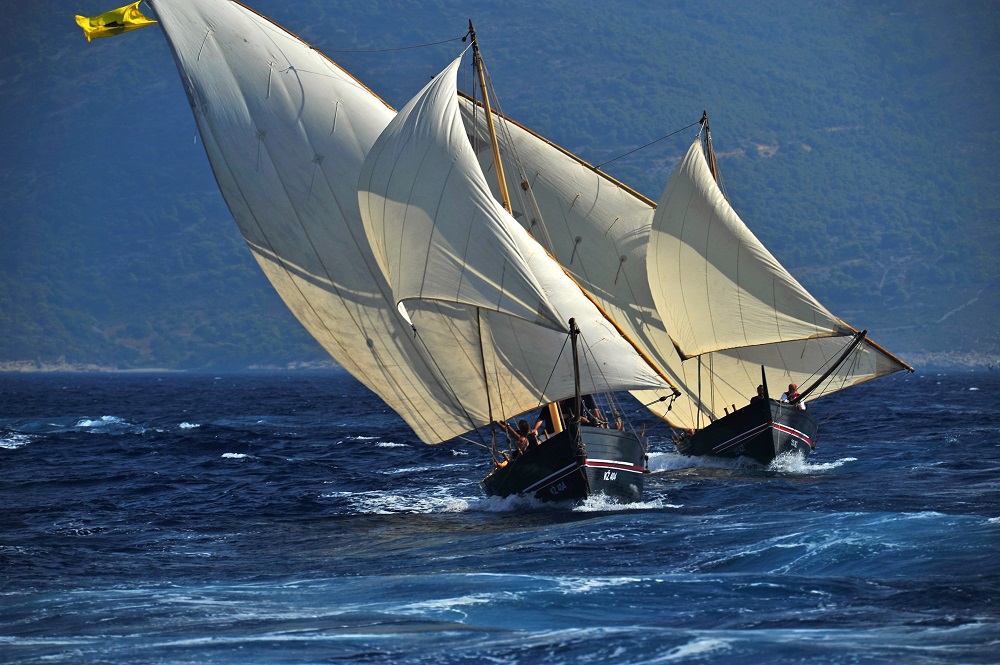
The people of Komiža are proud of Gajeta Falkuša, but it almost disappeared as the storm on Biševo island wrecked the last Gajeta Falkuša named Cicibela.
This terrible damage was repaired by professor Joško Božanić and Velmir Salamon who carried out research on Falkuša for eleven years and all of the aspects essential for this boat, including halieutic, cultural and anthropological interpretation, which included language, lexicon, literature, fishing history, toponymy and anthroponymy, shipbuilding, the art of sailing, traditional weather forecasting, the art of fishing, and even gastronomy.
In 1997 this traditional boat was saved in the form of ''Comeza-Lisboa'', the first falkuša built after many years, as part of the research project of the Cultural Association Ars Halieutica from Komiža. ''Comeza- Lisboa'' was presented at the world expo in Lisbon, Portugal. This launching was a historical moment for Komiža, where old fishing traditions, knowledge and skills were revitalised and presented to locals. Today we have four Gajeta Falkuša boats: Comeza-Lisboa, Mikula, Palagruža and Molo.
Molo is a smaller variant of Falkuša on which children used to learn fishing skills.
Dry stone walling
This piece of UNESCO heritage is an art of its own and is an old tradition which continues to be nurtured on numerous islands and in coastal Croatia, but it's especially interesting on the island of Vis. This type of rural architecture is part of the Vis landscape and has a different form than the rest. The story of dry stone walling is a story about survival, where peasants used their skills in rocky landscapes and securing smaller fertile areas to grow their vineyards and deal with other types of agriculture.

On Vis, the village of Dragodid near Komiža is very well known for its dry stone walling heritage and remains a place for dry stone workshops to this very day.
.jpg)
The Cokavian dialect of Vis
This is another piece of intangible heritage of Croatia and the oldest Slavic dialect in the Eastern Adriatic. It is unique in the fact that it preserves the lexicon from the lingua franca idiom, which is characteristic for the maritime and fishing world. Here is an example of the traditional cokavian dialect of Vis:
U śpȍmen nȍni Juvãni
Śvãku jȕtro
cîn bi źorâ źarudȉla
cîn bi źvȍna źaźvonȉla
ol śnâ bi śe vãrgla
pôk bi źavōpȉla
Ôva Marȉja
śvãki dôn źa pūlnê
kal bi śûnca grûźd śaźrîl
a iź kanpanȅla śe źvûn jōvîl
ol śtolâ bi śe dvȉgla
pôk bi źlãmen
krīźâ ucinȉla
Ôva Marȉja
ondâ jȍpet u śutûn
źajȅcol bi źvûn
a nâ bi pośôl dofinȉla
pôk bi śȅla u kantûn
krȕnicu molȉla
glōvûn obandovãla
kriźȉć buśivãla
i źãrno po źãrno
prȉko pãrśta voltovãla
Ôva Marȉja
i ȍto tãko je nȍna
iś Gūśpûn cavarjãla
trî pūtâ nã don
na plãc źvȍna
molȉtve olpivãla
i da śe nî śvȁ
u molȉtvu pritumbãla
do glũhe źemjê
da nî prĩgla śȉju
śigûr śon
jȍś bi vãvik
naźdrovjãla
Ôvu Marȉju
- Vinko Kalinić (From the collection of songs)
SOURCE(S) (text and photos): UNESCO, Geopark Vis
Find out more about Croatia's incredible UNESCO heritage by following our dedicated lifestyle page.
Go to Visovac Island for Free Between 09:30 and 10:45 on Sundays!
As Poslovni Dnevnik writes on the 23rd of May, 2019, enjoying nature and the peace of the beautiful little island of Visovac is the main motive of the visitors who come here to get away from the hustle and bustle of daily life and to be filled with new energy. The peaceful draw of this island on Visovac Lake, between the Roški slap and the Skradinski buk, is something special indeed.
When it comes to the question of just why this unassuming little pearl of the Krka National Park has always been a place for prayer and reflection, or simply a place to take in the vibrant nature, it's best to seek the answer yourself.
Visovac was first settled by the hermits, more specifically deserters of the Order of St. Augustine, who built a smaller monastery and a small church dedicated to St. The apostle Paul on the island, the Franciscans then arrived on the island after their departure.
Since the mid-fifteenth century, the Franciscan monastery and the Church of Our Lady of Visovac have been located there, which together with the natural landscape itself, make for a truly unique little island. The monastery boasts a valuable archaeological collection, as well as a varied collection of historical objects and a valuable library.
The enchanting nature of Visovac Lake and Krka National Park was quickly recognised and valued by producers, and back in the 1960s, this little island was the ideal place, what with its untouched beauty, to play the location at which the Native Americans once lived, depicted in the adventures of Winnetou. Four years ago, there was yet another new trilogy shot at Visovac.
Boats are sailing to Visovac from Stinica and Remetić.
"On Sunday, visitors to the island will enjoy free transport the boats from Stinica and Remetić, but only when the departures for masses leave (09:30/45, 10:00/15, and 10:30/45, and the boats return immediately after the end of the masses). As for the rest of the days, the boats sail to Visovac at their normal price and with the regular cruise line for Krka NP,'' writes Visovac.hr
The National Park organises excursions by boat from Skradinski buk for which its wise to set aside around two hours. A somewhat longer tour lasts for four hours, and it includes the beauty of Skradinski buk and Roški slap, as well as including Visovac. The prices are from 35 to 130 kuna per person, and children get free tickets up until four years of age, reports PunKufer.
Make sure to follow our dedicated lifestyle page for much more.
New Fast Line to Connect Croatian Islands May be Tourist Hit
The residents of Croatian islands often have rightful complaints about their connections to the mainland not being up to scratch in many cases, and while efforts are being made to create better, more reliable and more frequent connections between Croatia's many inhabited islands and the mainland, many remain less than satisfied.
As Poslovni Dnevnik writes on the 22nd of May, 2019, the carrier of this idea and the launcher of the line itself is the company GV Line Iadera from the Dalmatian city of Zadar which has many years of experience in navigation on important state routes under its belt.
Every single day as of June the 15th to September the 15th, there will be a fast passenger line on the Rijeka-Zadar route and this will also connect the islands of Krk, Rab, and Pag. This is otherwise the first and the quickest fast passenger line to connect Zadar and Rijeka and the islands in this manner, as 24sata reports.
This new line will certainly contribute to not only the ease of the lives of the residents of the aforementioned islands, but also to the overall enrichment of the tourist offer of both Dalmatia and Kvarner respectively, as well as to the better linking of the islands, since the islands of Krk, Rab and Pag have never been connected in such a way with each other, nor have they ever been connected in this way to the Croatian mainland.
Make sure to follow our dedicated travel and lifestyle pages for much more.
Pag Riva Renovated, Reconstruction Stands at 5.8 Million Kuna
A bit of ''cosmetic surgery'' for Pag's main waterfront (riva) as the reconstruction and upgrading of this heavily frequented area gives the town and the island a breath of new life.
As Novac/Jutarnji writes on the 19th of May, 2019, in approximately twenty days, the reconstruction and upgrading of the popular island's main waterfront with a small harbour in the town of Pag, ''Katina'', will finally be completed, and then that part of the coastline in Pag will be ''released'' for general use in its brand new, done up and completely revised edition.
In the reconstruction of Katina harbour, the Zadar Port Authority, with partial support from the Ministry of Maritime Affairs, Transport and Infrastructure headed by Oleg Butković, and Zadar County, invested a massive 5.8 million kuna, and the necessary works were executed by the Zagreb-based company PGP.
The aforementioned works saw the deepening of the bay area in front of Katina, an important coastal wall was properly repaired and two 50 and 80 metre-long pontoons were erected, which resulted in one hundred new berths for boats, according to a report from Zadarski.hr.
At the celebration of the Day of the City of Pag which took place on Friday, the project was presented to the participants of Pag's annual celebration, including to the minister of the competent Ministry, Oleg Butković. Pag riva's new look was presented by Davor Škibola, the director of the Zadar County Port Authority which, as mentioned, was among the investors.
On this occasion, Minister Butković referred to this particular port authority as "the best in Croatia" primarily because of the number of projects it has accomplished or performed in the port areas it manages.
Make sure to stay up to date by following our dedicated lifestyle page for much more.
Click HERE for images of Pag's brand new waterfront by night.





.JPG)
